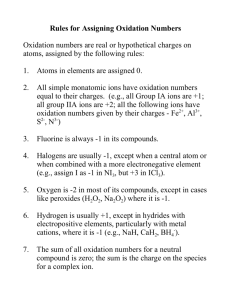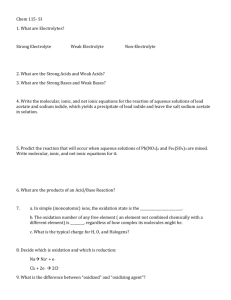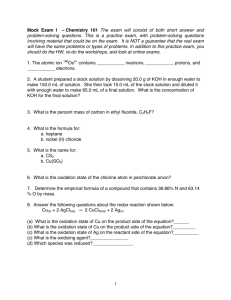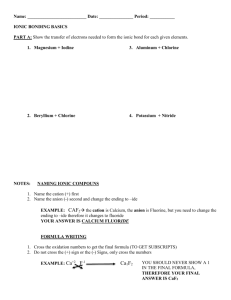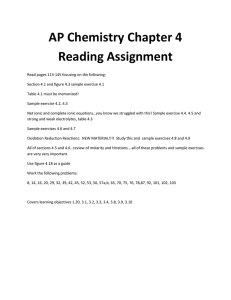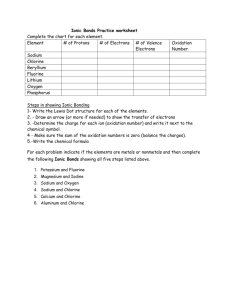Document
advertisement
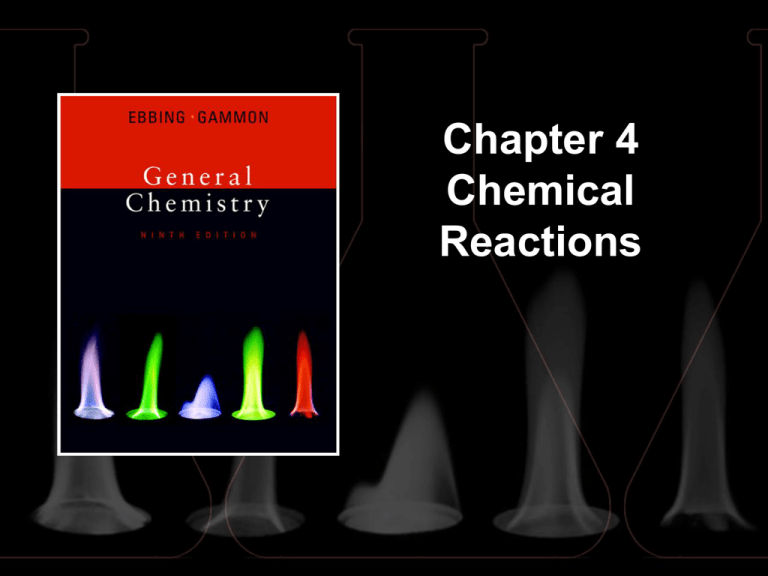
Chapter 4 Chemical Reactions Contents and Concepts Ions in Aqueous Solution Explore how molecular and ionic substances behave when they dissolve in water to form solutions. 1. Ionic Theory of Solutions and Solubility Rules 2. Molecular and Ionic Equations 4|2 Types of Chemical Reactions Investigate several important types of reactions that typically occur in aqueous solution: precipitation reactions, acid–base reactions, and oxidation–reduction reactions. 3. Precipitation Reactions 4. Acid–Base Reactions 5. Oxidation–Reduction Reactions 6. Balancing Simple Oxidation–Reduction Equations 4|3 Working with Solutions Now that we have looked at how substances behave in solution, it is time to quantitatively describe these solutions using concentration. 7. Molar Concentration 8. Diluting Solutions Quantitative Analysis Using chemical reactions in aqueous solution, determine the amount of substance or species present in materials. 9. Gravimetric Analysis 10. Volumetric Analysis 4|4 Learning Objectives Ions in Aqueous Solution 1. Ionic Theory of Solutions and Solubility Rules a. Describe how an ionic substance can form ions in aqueous solution. b. Explain how an electrolyte makes a solution electrically conductive. c. Give examples of substances that are electrolytes. d. Define nonelectrolyte and provide an example of a molecular substance that is a nonelectrolyte. 4|5 e. Compare the properties of solutions that contain strong electrolytes and weak electrolytes. f. Learn the solubility rules for ionic compounds. g. Use the solubility rules. 4|6 2. Molecular and Ionic Equations a. Write the molecular equation of a chemical reaction. b. From the molecular equations for both strong electrolytes and weak electrolytes, determine the complete ionic equation. c. From the complete ionic equation, write the net ionic equation. d. Write net ionic equations. 4|7 Types of Chemical Reactions 3. Precipitation Reactions a. Recognize precipitation (exchange) reactions. b. Write molecular, complete ionic, and net ionic equations for precipitation reactions. c. Decide whether a precipitation reaction will occur. d. Determine the product of a precipitation reaction. 4|8 4. Acid–Base Reactions a. Understand how an acid–base indicator is used to determine whether a solution is acidic or basic. b. Define Arrhenius acid and Arrhenius base. c. Write the chemical equation of an Arrhenius base in aqueous solution. d. Define Brønsted–Lowry acid and Brønsted–Lowry base. e. Write the chemical equation of a Brønsted–Lowry base in aqueous solution f. Write the chemical equation of an acid in aqueous solution using the hydronium ion. g. Learn the common strong acids and strong bases. 4|9 h. Distinguish between a strong acid and a weak acid and the solutions they form. i. Distinguish between a strong base and a weak base and the solutions they form. j. Classify acids and bases as strong or weak. k. Recognize neutralization reactions. l. Write an equation for a neutralization reaction. m. Write the reaction equations for a polyprotic acid in aqueous solution n. Recognize acid–base reactions that lead to gas formation. o. Write an equation for a reaction with gas formation. 4 | 10 5. Oxidation–Reduction Reactions a. Define oxidation–reduction reaction. b. Learn the oxidation-number rules. c. Assign oxidation numbers. d. Write the half-reactions of an oxidation– reduction reaction. e. Determine the species undergoing oxidation and reduction. f. Recognize combination reactions, decomposition reactions, displacement reactions, and combustion reactions. g. Use the activity series to predict when displacement reactions will occur. 4 | 11 6. Balancing Simple Oxidation–Reduction Equations a. Balance simple oxidation–reduction reactions by the half-reaction method. 4 | 12 Working with Solutions 7. Molar Concentration a. Define molarity or molar concentration of a solution. b. Calculate the molarity from mass and volume. c. Use molarity as a conversion factor. 8. Diluting Solutions a. Describe what happens to the concentration of a solution when it is diluted. b. Perform calculations associated with dilution. c. Describe the process for diluting a solution. 4 | 13 Quantitative Analysis 9. Gravimetric Analysis a. Determine the amount of a species by gravimetric analysis. 10. Volumetric Analysis a. Calculate the volume of reactant solution needed to perform a titration. b. Understand how to perform a titration. c. Calculate the quantity of substance in a titrated solution. 4 | 14 A strong electrolyte dissolves to produce ions. The ions, as moving charges, complete the circuit. When a light bulb is attached to the circuit, it shines. 4 | 15 A strong electrolyte is an electrolyte that exists in solution almost entirely as ions. 4 | 16 A weak electrolyte is an electrolyte that dissolves in water to give a relatively small percentage of ions. As a result, the light bulb shines weakly. 4 | 17 Compounds that dissolve readily are said to be soluble. Compounds that dissolve very little are said to be insoluble. 4 | 18 Solubility Rules 1. Group IA and ammonium compounds are soluble. 2. Acetates and nitrates are soluble. 3. Most chlorides, bromides, and iodides are Exceptions: AgCl, Hg2Cl2, PbCl2; AgBr, Hg2Br2, HgBr2, PbBr2; AgI, Hg2I2, HgI2, PbI2 4. Most sulfates are soluble. Exceptions: CaSO4, SrSO4, BaSO4, Ag2SO4, Hg2SO4, PbSO4 soluble. 4 | 19 5. Most carbonates are insoluble. Exceptions: Group IA carbonates and (NH4)2SO4 6. Most phosphates are insoluble. Exceptions: Group IA phosphates and (NH4)3PO4 7. Most sulfides are insoluble. Exceptions: Group IA sulfides and (NH4)2S 8. Most hydroxides are insoluble. Exceptions: Group IA hydroxides, Ca(OH)2, Sr(OH)2, Ba(OH)2 4 | 20 Molecular Equation A chemical equation in which the reactants and products are written as if they were molecular substances, even though they may actually exist in solution as ions. State symbols are include: (s), (l), (g), (aq). For example: AgNO3(aq) + NaCl(aq) AgCl(s) + NaNO3(aq) Although AgNO3, NaCl, and NaNO3 exist as ions in aqueous solutions, they are written as compounds in the molecular equation. 4 | 21 Complete Ionic Equation A chemical equation in which strong electrolytes are written as separate ions in the solution. Other reactants and products are written in molecular form. State symbols are included: (s), (l), (g), (aq). For example: AgNO3(aq) + NaCl(aq) AgCl(s) + NaNO3(aq) In ionic form: Ag+(aq) + NO3-(aq) + Na+(aq)Cl-(aq) AgCl(s) + Na+(aq) + NO3-(aq) 4 | 22 Spectator Ion An ion in an ionic equation that does not take part in the reaction. It appears as both a reactant and a product. 4 | 23 Net Ionic Equation A chemical equation in which spectator ions are omitted. It shows the reaction that actually occurs at the ionic level. For example: Ag+(aq) + NO3-(aq) + Na+(aq) + Cl-(aq) AgCl(s) + Na+(aq) + NO3-(aq) In net ionic form: Ag+(aq) + Cl-(aq) AgCl(s) 4 | 24 ? Decide whether the following reaction occurs. If it does, write the molecular, ionic, and net ionic equations. KBr + MgSO4 1. Determine the product formulas: K+ and SO42- make K2SO4 Mg2+ and Br- make MgBr2 2. Determine whether the products are soluble: K2SO4 is soluble MgBr2 is soluble KBr + MgSO4 no reaction 4 | 25 ? Decide whether the following reaction occurs. If it does, write the molecular, ionic, and net ionic equations. NaOH + MgCl2 1. Determine the product formulas: Na+ and Cl- make NaCl Mg2+ and OH- make Mg(OH)2 2. Determine whether the products are soluble: NaCl is soluble Mg(OH)2 is insoluble 4 | 26 Molecular Equation (Balance the reaction and include state symbols) 2NaOH(aq) + MgCl2(aq) 2NaCl(aq) + Mg(OH)2(s) Ionic Equation 2Na+(aq) + 2OH-(aq) + Mg2+(aq) + 2Cl-(aq) 2Na+(aq) + 2Cl-(aq) + Mg(OH)2(s) Net Ionic Equation 2OH-(aq) + Mg2+(aq) Mg(OH)2(s) 4 | 27 ? Decide whether the following reaction occurs. If it does, write the molecular, ionic, and net ionic equations. K3PO4 + CaCl2 1. Determine the product formulas: K+ and Cl- make KCl Ca2+ and PO43- make Ca3(PO4)2 2. Determine whether the products are soluble: KCl is soluble Ca3(PO4)2 is insoluble 4 | 28 Molecular Equation (Balance the reaction and include state symbols) 2K3PO4(aq) + 3CaCl2(aq) 6KCl(aq) + Ca3(PO4)2(s) Ionic Equation 6K+(aq) + 2PO43-(aq) + 3Ca2+(aq) + 6Cl-(aq) 6K+(aq) + 6Cl-(aq) + Ca3(PO4)2(s) Net Ionic Equation 2PO43-(aq) + 3Ca2+(aq) Ca3(PO4)2(s) 4 | 29 Types of Chemical Reactions 1. Precipitation reactions: a solid ionic substance forms from the mixture of two solutions of ionic substances. 2. Acid–base reactions: reactions that involve the transfer of a proton (H+) between reactants 3. Oxidation–reduction reactions: reactions that involve the transfer of electrons between reactants. 4 | 30 A precipitate is an insoluble solid compound formed during a chemical reaction in solution. Predicting Precipitation Reactions 1. Predict the products (exchange of parts). 2. Determine the state of each product: (s), (l), (g), (aq). 3. If all products are aqueous (aq), no net reaction occurred. 4 | 31 Arrhenius Acid A substance that produces hydrogen ions, H+, when it dissolves in water. Arrhenius Base A substance that produces hydroxide ions, OH-, when it dissolves in water. 4 | 32 Brønsted–Lowry Acid The species (molecule or ion) that donates a proton to another species in a proton-transfer reaction Brønsted–Lowry Base The species (molecule or ion) that accepts a proton from another species in a proton-transfer reaction 4 | 33 Household Acids and Bases 4 | 34 Acid-Base Indicator A dye used to distinguish between an acidic and basic solution by means of the color changes it undergoes in these solutions. The sample beakers show a red cabbage indicator in beakers varying in acidity from highly acidic (left) to highly basic (right). 4 | 35 Strong Acid An acid that ionizes completely in water. It is present entirely as ions; it is a strong electrolyte. Common strong acids: HNO3 H2SO4 HCl HBr HClO4 HI 4 | 36 Weak Acid An acid that only partly ionizes in water. It is present primarily as molecules and partly as ions; it is a weak electrolyte. If an acid is not strong, it is weak. 4 | 37 In Figure A, a solution of HCl (a strong acid) illustrated on a molecular/ionic level, shows the acid as all ions. In Figure B, a solution of HF (a weak acid) also illustrated on a molecular/ionic level, shows mostly molecules with very few ions. 4 | 38 Strong Base A base that ionizes completely in water. It is present entirely as ions; it is a strong electrolyte. Common strong bases: LiOH NaOH Ca(OH)2 Sr(OH)2 KOH Ba(OH)2 4 | 39 Weak Base A base that is only partly ionized in water. It is present primarily as molecules and partly as ions; it is a weak electrolyte. These are often nitrogen bases such as NH3: NH3(aq) + H2O(l) NH4+(aq) + OH-(aq) If a base is not strong, it is weak. 4 | 40 ? Classify the following as strong or weak acids or bases: a. KOH b. H2S c. CH3NH2 d. HClO4 a. b. c. d. KOH is a strong base. H2S is a weak acid. CH3NH2 is a weak base. HClO4 is a strong acid 4 | 41 Polyprotic Acid An acid that results in two or more acidic hydrogens per molecule For example: H2SO4, sulfuric acid 4 | 42 Neutralization Reaction A reaction of an acid and a base that results in an ionic compound (a salt) and possibly water. 4 | 43 ? Write the molecular, ionic, and net ionic equations for the neutralization of sulfurous acid, H2SO3, by potassium hydroxide, KOH. 4 | 44 Molecular Equation (Balance the reaction and include state symbols) H2SO3(aq) + 2KOH(aq) 2H2O(l) + K2SO3(aq) Ionic Equation H2SO3(aq) + 2K+(aq) + 2OH-(aq) 2H2O(l) + 2K+(aq) + SO32-(aq) Net Ionic Equation H2SO3(aq) + 2OH-(aq) 2H2O(l) + SO32-(aq) 4 | 45 Acid-Base Reaction with Gas Formation Some salts, when treated with an acid, produce a gas. Typically sulfides, sulfites, and carbonates behave in this way producing hydrogen sulfide, sulfur trioxide, and carbon dioxide, respectively. The photo to the right shows baking soda (sodium hydrogen carbonate) reacting with acetic acid in vinegar to give bubbles of carbon dioxide. 4 | 46 Gas-forming acid–base reactions: Na2S(aq) + 2HCl(aq) 2NaCl(aq) + H2S(g) Na2CO3(aq) + 2HCl(aq) 2NaCl(aq) + H2O(l) + CO2(g) Na2SO3(aq) + 2HCl(aq) 2NaCl(aq) + H2O(l) + SO2(g) 4 | 47 ? Write the molecular, ionic, and net ionic equations for the reaction of copper(II) carbonate with hydrochloric acid. 4 | 48 Molecular Equation (Balance the reaction and include state symbols) CuCO3(s) + 2HCl(aq) CuCl2(aq) + H2O(l) + CO2(g) Ionic Equation CuCO3(s) + 2H+(aq) + 2Cl-(aq) Cu2+(aq) + 2Cl-(aq) + H2O(l) + CO2(g) Net Ionic Equation CuCO3(s) + 2H+(aq) Cu2+(aq) + H2O(l) + CO2(g) 4 | 49 Oxidation Number For a monatomic ion, the actual charge of the atom or a hypothetical charge assigned to the atom in the substance using simple rules. 4 | 50 Rules for Assigning Oxidation Numbers 1. Elements: The oxidation number of an atom in an element is zero. 2. Monatomic ions: The oxidation number of an atom in a monatomic ion equals the charge on the ion. 3. Oxygen: The oxidation number of oxygen is -2 in most of its compounds. (An exception is O in H2O2 and other peroxides, where the oxidation number is -1.) 4. Hydrogen: The oxidation number of hydrogen is +1 in most of its compounds. (The oxidation number of hydrogen is -1 in binary compounds with a metal such as CaH2. 4 | 51 5. Halogens: The oxidation number of fluorine is -1. Each of the other halogens (Cl, Br, I) has an oxidation number of -1 in binary compounds, except when the other element is another halogen above it in the periodic table or the other element is oxygen. 6. Compounds and ions: The sum of the oxidation numbers of the atoms in a compound is zero. The sum of the oxidation numbers of the atoms in a polyatomic ion equals the charge on the ion. 4 | 52 ? Potassium permanganate, KMnO4, is a purple-colored compound; potassium manganate, K2MnO4, is a greencolored compound. Obtain the oxidation numbers of the manganese in these compounds. K Mn O 1(+1) + 1(oxidation number of Mn) + 4(-2) = 0 1 + 1(oxidation number of Mn) + (-8) = 0 (-7) + (oxidation number of Mn) = 0 Oxidation number of Mn = +7 4 | 53 K Mn O 2(+1) + 1(oxidation number of Mn) + 4(-2) = 0 2 + 1(oxidation number of Mn) + (-8) = 0 (-6) + (oxidation number of Mn) = 0 Oxidation number of Mn = +6 In KMnO4, the oxidation number of Mn is +7. In K2MnO4, the oxidation number of Mn is +6. 4 | 54 ? What is the oxidation number of Cr in dichromate, Cr2O72-? Cr O 2(oxidation number of Cr) + 7(-2) = -2 2(oxidation number of Cr) + (-14) = -2 2(oxidation number of Cr) = -12 Oxidation number of Cr = +6 4 | 55 Half-reaction One of two parts of an oxidation–reduction reaction, one part of which involves a loss of electrons (or increase in oxidation number) and the other part of which involves a gain of electrons (or decrease in oxidation number). 4 | 56 Oxidation The half-reaction in which there is a loss of electrons by a species (or an increase in oxidation number). Reduction The half-reaction in which there is a gain of electrons by a species (or a decrease in oxidation number). 4 | 57 Oxidizing Agent A species that oxidizes another species; it is itself reduced. Reducing Agent A species that reduces another species; it is itself oxidized. 4 | 58 Common Oxidation–Reduction Reactions 1. Combination reaction 2. Decomposition reaction 3. Displacement reaction 4. Combustion reaction 4 | 59 Combination Reaction A reaction in which two substances combine to form a third substance. For example: 2Na(s) + Cl2(g) 2NaCl(s) 4 | 60 Decomposition Reaction A reaction in which a single compound reacts to give two or more substances. For example: 2HgO(s) 2Hg(l) + O2(g) 4 | 61 Displacement Reaction A reaction in which an element reacts with a compound, displacing another element from it. For example: Zn(s) + 2HCl(aq) H2(g) + ZnCl2(aq) 4 | 62 Combustion Reaction A reaction in which a substance reacts with oxygen, usually with the rapid release of heat to produce a flame. For example: 4Fe(s) + 3O2(g) 2Fe2O3(s) 4 | 63 Balancing Simple Oxidation-Reduction Reactions: Half-Reaction Method First, identify what is oxidized and what is reduced by determining oxidation numbers. 4 | 64 For the reaction Zn(s) + Ag+(aq) Zn2+(aq) + Ag(s) 0 +1 +2 0 Zn is oxidized from 0 to +2. Ag+ is reduced from +1 to 0. 4 | 65 Next, write the unbalanced half-reactions. Zn(s) Zn2+(aq) (oxidation) Ag+(aq) Ag(s) (reduction) Now, balance the charge in each half reaction by adding electrons. Zn(s) Zn2+(aq) + 2e(oxidation) e- + Ag+(aq) Ag(s) (reduction) 4 | 66 Since the electrons lost in oxidation are the same as those gained in reduction, we need each halfreaction to have the same number of electrons. To do this, multiply each half-reaction by a factor so that when the half-reactions are added, the electrons cancel. Zn(s) Zn2+(aq) + 2e2e- + 2Ag+(aq) 2Ag(s) (oxidation) (reduction) 4 | 67 Lastly, add the two half-reactions together. Zn(s) + 2Ag+(aq) Zn2+(aq) + 2Ag(s) 4 | 68 ? Balance the following oxidationreduction reaction: FeI3(aq) + Mg(s) Fe(s) + MgI2(aq) The oxidation numbers are given below the reaction. FeI3(aq) + Mg(s) Fe(s) + MgI2(s) +3 -1 0 0 +2 -1 Now, write the half-reactions. Since Iodide is a spectator ion it is omitted at this point. Mg(s) Mg2+(aq) (oxidation) Fe3+(aq) Fe(s) (reduction) 4 | 69 Balancing the half-reactions: Mg(s) Mg2+(aq) + 2eFe3+(aq) + 3e- Fe(s) (oxidation) (reduction) Multiply the oxidation half-reaction by 3 and the reduction half-reaction by 2. 3Mg(s) 3Mg2+(aq) + 6e- (oxidation) 2Fe3+(aq) + 6e- 2Fe(s) (reduction) 4 | 70 Add the half-reactions together. 2Fe3+(aq) + 3Mg(s) 2Fe(s) + 3Mg2+(aq) Now, return the spectator ion, I-. 2FeI3(aq) + 3Mg(s) 2Fe(s) + 3MgI2(aq) 4 | 71 Molar Concentration, Molarity, (M) Moles of solute per liter of solution moles of solute Molarity (M ) liters of solution 4 | 72 To prepare a solution, add the measured amount of solute to a volumetric flask, then add water to bring the solution to the mark on the flask. 4 | 73 Dilution When a higher concentration solution is used to make a lessconcentration solution, the moles of solute are determined by the amount of the higher-concentration solution. The number of moles of solute remains constant. MiVi = MfVf Note: The units on Vi and Vf must match. 4 | 74 Diluting a solution quantitatively requires specific glassware. The photo at the right shows a volumetric flask used in dilution. 4 | 75 ? You place a 1.62-g of potassium dichromate, K2Cr2O7, into a 50.0-mL volumetric flask. You then add water to bring the solution up to the mark on the neck of the flask. What is the molarity of K2Cr2O7 in the solution? Molar mass of K2Cr2O7 is 294 g. 1 mol 1.52 g 294 g 0.103 M -3 50.0 x 10 L 4 | 76 ? A solution of sodium chloride used for intravenous transfusion (physiological saline solution) has a concentration of 0.154 M NaCl. How many moles of NaCl are contained in 500.-mL of physiological saline? How many grams of NaCl are in the 500.-mL of solution? mol M L 0.154 M 0.500 L 0.0770 mol NaCl Molar mass NaCl 58.4 g 58.4 g 0.0770 mol 1 mol 4.50 g NaCl 4 | 77 ? A saturated stock solution of NaCl is 6.00 M. How much of this stock solution is needed to prepare 1.00-L of physiological saline soluiton (0.154 M)? M iVi M fVf M fVf Vi Mi (0.154 M )(1.00 L) Vi 6.00 M Vi 0.0257 L or 25.7 mL 4 | 78 Quantitative Analysis The determination of the amount of a substance or species present in a material. 4 | 79 Gravimetric Analysis A type of quantitative analysis in which the amount of a species in a material is determined by converting the species to a product that can be isolated completely and weighed. 4 | 80 The figure on the right shows the reaction of Ba(NO3)2 with K2CrO4 forming the yellow BaCrO4 precipitate. 4 | 81 The BaCrO4 precipitate is being filtered in the figure on the right. It can then be dried and weighed. 4 | 82 ? A soluble silver compound was analyzed for the percentage of silver by adding sodium chloride solution to precipitate the silver ion as silver chloride. If 1.583 g of silver compound gave 1.788 g of silver chloride, what is the mass percent of silver in the compound? 4 | 83 Molar mass of silver chloride (AgCl) = 143.32 g 1 mol AgCl 1 mol Ag 107.9 g Ag 1.788 g AgCl x x x 143.32 g AgCl 1 mol AgCl 1 mol Ag = 1.346 g Ag in the compound 1.346 g Ag 100% 1.583 g silver compound = 85.03% Ag 4 | 84 Titration A procedure for determining the amount of substance A by adding a carefully measured volume with a known concentration of B until the reaction of A and B is just complete. 4 | 85 In the titration above, the indicator changes color to indicate when the reaction is just complete. 4 | 86 Volumetric Analysis A type of quantitative analysis based on titration 4 | 87 ? Zinc sulfide reacts with hydrochloric acid to produce hydrogen sulfide gas: ZnS(s) + 2HCl(aq) ZnCl2(aq) + H2S(g) How many milliliters of 0.0512 M HCl are required to react with 0.392 g ZnS? 4 | 88 Molar mass of ZnS = 97.45 g 1 mol ZnS 2 mol HCl 1L solution 0.392 g ZnS x x x 97.45 g ZnS 1 mol ZnS 0.0512 mol HCl = 0.157 L = 157 mL HCl solution 4 | 89 A dilute solution of hydrogen peroxide is sold in drugstores as a mild antiseptic. A typical solution was analyzed for the percentage of hydrogen peroxide by titrating it with potassium permanganate: 5H2O2(aq) + 2KMnO4(aq) + 6H+(aq) 8H2O(l) + 5O2(g) + 2K+(aq) + 2Mn2+(aq) ? What is the mass percent of H2O2 in a solution if 57.5 g of solution required 38.9 mL of 0.534 M KMnO4 for its titration? 4 | 90 Molar mass of H2O2 = 34.01 g 0.534 mol KMnO 4 5 mol H2 O 2 34.01 g H2 O 2 38.9 x 10 L x x x 1L 2 mol KMnO 4 1 mol H2 O 2 3 = 1.77 g H2O2 1.77 g H2 O 2 100% 57.5 g solution = 3.07% H2O2 4 | 91


